| Location | Travel | Insurance | Visas | Moscow | Weather | Clothing and kit |
Accommodation | Food |
Summit day |
Hygiene |
Where is Mount Elbrus?
Mount Elbrus is situated in the Western Caucasus Mountain Range near the border of Georgia with the south side in the Russian republic of Kabardino-Balkyrie and the north side in the republic of Karachay-Cherkessia.
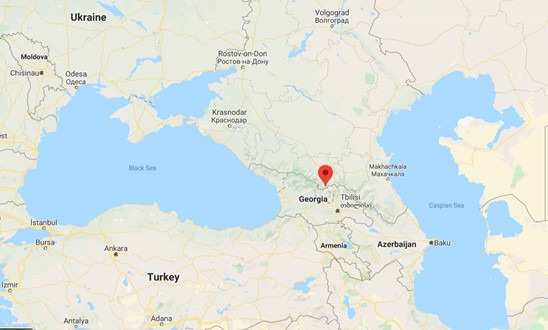
The small republic of Kabardino Balkaria is just 12,500 sq kms in the north Caucasus with a population of just under one million, made up of Kabardanians in the lowlands and Balkarians in the mountainous area. Karachay -Cherkessia has an area of 14,100 sq kms and a population of just around half a million. The Karachay and Cherkess are two separate Muslim peoples.
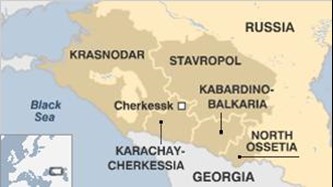
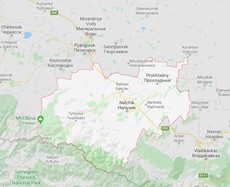
Prielbrusie is the national park around Mt. Elbrus and is the most frequented area in the Central Caucasus and Elbrus itself is a popular ski resort for Russians.
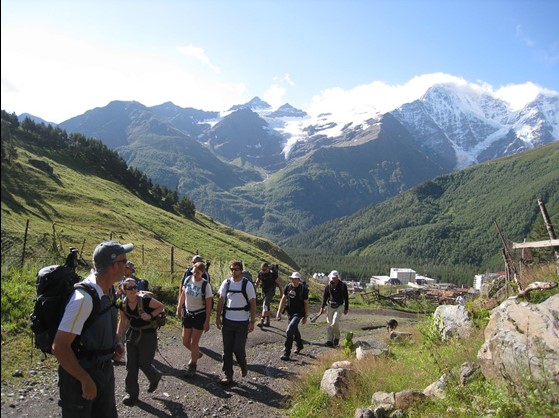
How do I get to Elbrus?
Whether you want to climb Elbrus by the south or north routes, the first step is to get to Mineralnye Vody airport and in almost every case this means flying initially to Moscow and then taking the four hour flight directly south on either Aeroflot or S7 airlines.
From the UK or Ireland or indeed most places in Europe the best timing is to take an overnight flight to Moscow and then a morning flight to Mineralynye Vody, aiming to arriving late morning.
For people on the Elbrus South trip, you then take road transport to the Baksan Valley and the village of Terskol where there are plenty of hotels and restaurants. The journey takes about four hours and arriving early evening leaves plenty of time for settling in, having a meal and an early night.
For people on the Elbrus North or Traverse trips, the minibus takes you to the nearby town of Pyatigorsk about an hour from the airport. We overnight in a hotel and the next morning a more robust minibus will drive the four or five hours to the mountain, half of which is off road.
On the return, it's a good idea to take an early afternoon flight out of Mineralnye Vody. and then the evening flight out of Moscow. This means departing Terskol village or the north side base camp after breakfast at around 8.00am. For the North siders we often leave the campsite the day before, depending on the height of the river which needs to be crossed in the vehicles.
Travel insurance for Mount Elbrus
It's important that everyone gets travel insurance as soon after booking the trip as possible, but many UK insurance companies don't offer policies to this mountain because of the UK Government FCO advisories against travel for all but essential travel. However some specialist companies do offer policies and we recommend Campbell Irvine who we have used for many years.
Getting the Visa for Elbrus
The process is not difficult but it is a bit time consuming, and it begins about six weeks prior to the trip when we ask for your passport information so that we can process an invitation letter for you. The visa is quite specific with dates and places to be visited so if you plan to stay in Moscow or travel longer in Russia then we need to know the dates.
There is more information on our Practical Information page regarding the process itself. Be aware though that some nationalities require original visa invitations to be posted to them rather than soft copies which adds to the cost, and some nationalities require a more stringent process. In the UK now for example, every applicant must go in person to the nearest Russian visa office to submit their biometrics, and the three offices are in London, Edinburgh and Manchester. This means an additional cost to factor this visit in.
Moscow visit
A lot of people choose to visit Moscow and we can assist with your travel and accommodation needs. Please contact us for more information about airport transfers, recommended hotels and hiring our city guide. We can also pre-book tickets to events and to visit the Kremlin.
What is the weather like on Elbrus?
Elbrus is at a latitude of 42 degrees North, similar to that of Rome. However, due to its altitude and its surrounding mountain range, it can produce some extreme weather conditions and very low temperatures. You can see 6-day weather forecasts and temperatures for the mountain at different altitudes on Mountain Forecast.
During the climbing season from June to August expect warm sunny days with little precipitation in the valleys and progressively colder days and nights as you go higher on the mountain, with lows of minus 20 Celsius on the summit with windchill. Prepare for a wide diurnal temperature range which is tiring, and rapid change in weather conditions and especially visibility on the mountain.
Read more about the climate in this part of Russia on our General Information section.
What kit do I need for Elbrus?
Treat the Elbrus expedition as a winter climb, even if you are going in the stable months of July and August. The variation in weather is one of the main objective dangers on this mountain and it's important to be prepared for a wide range of weather and extreme windchill on the summit.
You can buy or rent the cold weather gear and the climbing equipment, but what you buy depends a lot on what other climbing you intend to do in the future. You can discuss with us any time about specific brands or models but the general requirements are below.
Boots - this climb requires plastic mountaineering boots but a high quality hybrid boot will be adequate. Take normal hiking boots for the acclimatisation treks but once on snow you will need to have good quality warm 'double' mountain boots. Also take hut shoes or sandals. Heavy wool socks for the days on snow and trekking socks for lower sections.
Hands - a good pair of waterproof, lined mountain mitts, fleece gloves and liner gloves.
Head and face - warm hat with ear covers if possible, and a sunhat. A buff or balaclava, high quality mountain sunglasses or glacier glasses, and goggles.
Body - You need good quality waterproofs, and a good quality down jacket with a hood and preferably long enough to cover the backside. Layering with several fleece layers and normally a single thermal layer is enough for summit day. Please note that the lightweight down jackets are not enough for the cold on Elbrus, they have to mountain quality down jackets which you can rent in the village if needs be.
Legs - trekking trousers and shorts and leggings for the valley walks, lined trousers or soft shell for up high with shell or over trousers against the wind and snow. Take a pair of thermal bottoms for summit day.
Rucksack - on the north route and traverse you will be doing carries of kit from base camp to high camp so a 75 litre sack is necessary plus you will need to use the larger rucksack to carry gear up like tents, food and stoves. On the south route a 40 litre day pack for the summit day is all you need, since your main kit will go up to the hut in the cable car. You also need a good duffle bag, especially the north siders, and a travel bag for leaving in the hotel.
Sleeping bag - on the north route it's best to opt for a four season bag since there is much more camping, whereas the warmer huts on the south side mean a 3 season bag will probably be enough.
Climbing equipment - for both routes on Elbrus you will need a pair of crampons, a walking axe, harness, slings and karabiners, trekking poles and a climbing helmet. All these can be rented from us.
Miscellaneous - water bottle, thermos flask, wash kit, personal first aid kit, trekking poles, plenty of sun cream and lip salve and moisturising cream, travel clothes and bag for leaving in the hotel, power bank and charging items for phone, tablet etc.
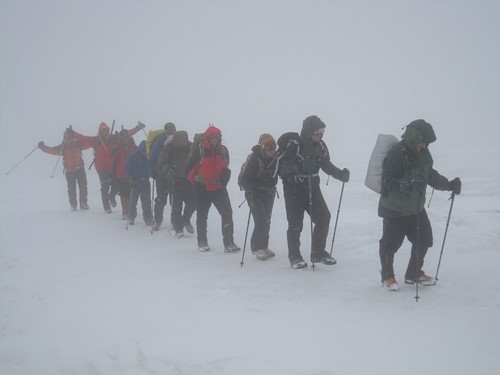
Low visibility on the lower slopes of the mountain. This photo is in the height of summer in July, but it could winter in Scotland.
Accommodation on Elbrus
For a full description of all the huts and accommodation on this trip, covering both north and south sides of the mountain, please have a look at the blog piece Huts on Elbrus.
The new National Park huts on the south side are heated and comfortable with bunks and mattresses in small dormitories. There is wi-fi and phone signal. A communal area for eating and relaxing is next to the kitchen. We would recommend a 3 season sleeping bag. We have an expedition cook who will prepare all the food for everyone throughout the trip but do bring some snacks and sweets from home.
On the north side the accommodation is in tents at base camp and in a fairly rudimentary hut at the snowline. Sometimes the team camp at the high Lenz Rocks before summit day, but only if the weather allows it. We would recommend 4 season sleeping bags and you will need a good quality sleeping mat.
Food preferences on Elbrus
The food in the restaurants in the Baksan valley restaurants is lovely and there's quite a range, but there's no doubt that they do not cater very well for vegetarian or vegan diets. There are plenty of soups and salads and breads though, but not many vegetarian recipes. Russians are meat lovers and the local dish of shashlyk - a lamb kebab roasted over an apple wood barbecue - is the national dish.
On the mountain we have a cook who prepares all the meals which again are quite limited in the range of ingredients, because the shops in the valley don't have a great stock. Plenty of soups and stews, potatoes and vegetables with some meat (tinned mostly, but sometimes chicken), sweets and snacks. Breakfast is mostly porridge, eggs and bread with cheese and sometimes muesli.
We won't be able to cater very well for some specific dietary requirements, for example celiacs. Gluten free food is not possible to buy. We would also advise you bring your own summit day snacks and foods, the shops locally don't sell any specialty energy bars or drinks. We will provide things like glucose biscuits and orange juice.
What to expect on an Elbrus summit day
Leaving the hut in the dark on summit morning you are likely to be in mountain boots and crampons, soft-shell or mountain trousers with base-layer tights, probably over-trousers, a base-layer and fleece mid-layers plus a down jacket. You'll also have a balaclava or buff, warm hat, liner gloves and thick windproof insulated gloves.You'll be carrying a pole and a walking axe and most likely have headtorch on.
In your day pack bag carry goggles, sunglasses, flask of hot drink, water bottle, snacks and harness/sling/karabiners/helmet which you will use for tying into the fixed line or into a man rope. For groups on the traverse you will have a bigger pack and include a sleeping bag and travel clothes for going over to the south side.
Leaving the hut at around 4am, most climbers on the south side opt for taking a ratrack to Pastukhov Rocks to start the day, while on the north side the hike begins from the tent at Lenz Rocks. Depending on weather the route could be icy and hard or soft with deep snow.
The day will be long on either route, estimate a twelve hour day and plan in terms of snacks and drinks. It's almost impossible to avoid getting dehydrated on a day like this and inevitably with such a big height gain you will feel the effects of altitude. Try to leave the hut as hydrated and well rested as possible and take plenty of snacks for the day.
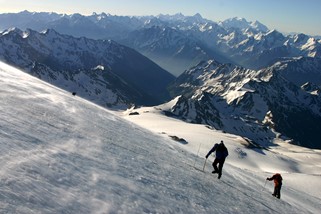
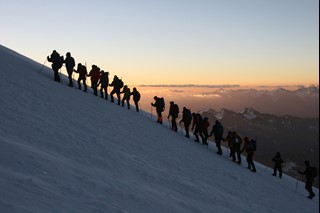
Left: Icy ground on the open slopes up to the Saddle require sharp points on your crampons and a walking axe.
Right: A clear beautiful morning on Elbrus, every person has the right kit and clothing and enough to cope with significant changes throughout the day.
Hygiene on Mount Elbrus
Toilets
All the huts and the campsite on the north side have outside latrines which are wooden huts with a floor and a long drop. Some latrines are worse than others, and it is not the job of the Rangers to clean them. Company staff can do this job, but under duress, since many of the problems are caused by people who miss the hole and don’t clean up afterwards.
Sometimes a visit to a latrine can be a dispiriting experience. It is important to take a torch with you at night and take a responsibility to keep the huts clean. Going to the toilet behind a rock is strictly forbidden and the authorities have the power to send people off the mountain if they are caught, and fine the company. We will provide toilet paper but by all means bring your own.
Rubbish Disposal
All rubbish is collected by the staff and carried down the mountain. Do not throw rubbish down the long drop (toilet paper is fine) and make a habit of picking up litter that you see on the trail. The responsibility for keeping the mountain clean is on the shoulders of every visitor.
Water
We do not bring bottled water on the mountain; we boil all water which comes from the rivers and glacial streams. The staff will fill your water bottles every evening. Do bring some water purification tablets for yourself if you would like the extra reassurance or something like a steripen.

